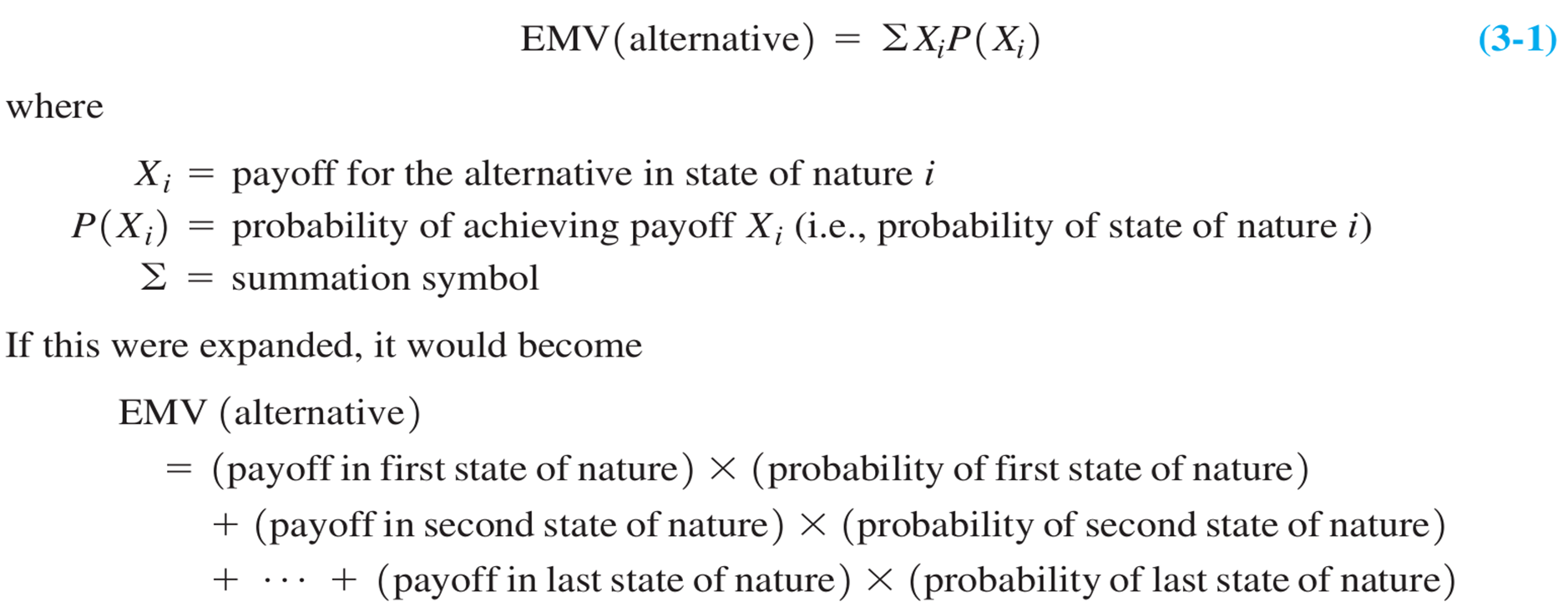Management Science (Decision Analysis)
1/46
There's no tags or description
Looks like no tags are added yet.
Name | Mastery | Learn | Test | Matching | Spaced |
|---|
No study sessions yet.
47 Terms
What are the six steps in decision making? PAID MA
Clearly define the problem at hand.
List the possible alternatives.
Identify the possible outcomes or states of nature.
List the payoff (typically profit) of each combination of alternatives and outcomes.
Select one of the mathematical decision theory models.
Apply the model and make your decision
The types of decisions people make depend on how much knowledge or information they have about the situation. There are three decision-making environments:
Decision making under certainty
Decision making under uncertainty
Decision making under risk
Decision making under certainty
People choose the alternative that will maximize their well-being or will result in the best outcome
Decision making under certainty
Decision makers know with certainty the consequences of every alternative or decision choice
Decision making under uncertainty
There are several possible outcomes for each alternative, the decision maker does not know the probabilities of the various outcomes.
Decision making under risk
There are several possible outcomes for each alternative, the decision maker knows the probability of occurrence of each outcome.
Decision making under risk
The decision maker usually attempts to maximize his or her expected well being.
Decision theory models in a risk environment typically employs two equivalent criteria;
maximization of expected monetary value
minimization of expected opportunity loss
What is the goal in decision theory models in a risky environment?
maximize profit
minimize opportunity loss
To determine the unknown probabilities of various outcomes in decision making under certainty the several criteria is followed: OPERM
Optimistic
Pessimistic
Criterion of realism
Equally likely
Minimax regret
The optimistic criteria is also known as
maximax
The pessimistic criteria is also known as
maximin
The criterion of realism criteria is also known as
Hurwicz
The equally likely criteria is also known as
Laplace
What criteria can be computed directly from the decision (payoff) table?
Optimistic
Pessimistic
Criterion of Realism
Equally likely
What does the minimax regret criterion require?
The use of the opportunity loss table
Optimistic
the best (maximum) payoff for each alternative is considered and the alternative with the best (maximum) of these is selected.
Pessimistic
The worst (minimum) payoff for each alternative is considered and the alternative with the best (maximum) of these is selected.
Criterion of realism is also often called…
The weighted average
Criterion of realism
the criterion of realism (the Hurwicz criterion) is a compromise between an optimistic and a pessimistic decision. To begin with, a coefficient of realism, , is selected;
When a coefficient of realism is selected, what does it measure?
this measures the degree of optimism of the decision maker.
The coefficient of realism is between…
0 and 1
When the coefficient is 1, that means…
The decision maker is 100% optimistic about the future
When the coefficient is 0, that means…
The decision maker is 100% pessimistic about the future.
What is the advantage of weighted average approach (criterion of realism)
it allows the decision maker to build in personal feelings about relative optimism and pessimism.
The weighted average is computed as follows:

Equally likely
Uses all the payoffs for each alternative is the equally likely. The equally likely approach assumes that all probabilities of occurrence for the states of nature are equal, and thus each state of nature is equally likely.
The computation of equally likely involves…
This involves finding the average payoff for each alternative, and selecting the alternative with the best or highest average.
Minimax regret
Based on opportunity loss or regret.
Opportunity loss
the difference between the optimal profit or payoff for a given state of nature and the actual payoff received for a particular decision.
Opportunity loss is also defined as…
the amount lost by not picking the best alternative in a given state of nature.
How is opportunity loss computed?
calculated by subtracting each payoff in the column from the best payoff in the same column.
Decision making under risk
The alternative with the maximum EMV is chosen.
What does EMV means?
Expected Monetary Value (EMV) is the weighted sum of possible payoffs for each alternative. Also, the long-run average value of that decision.
EMV is computed as…

In expected value of perfect information, will result to the following computations:
The expected value of perfect information (EVPI)
the expected value with perfect information (EVwPI)
EVPI…
Places an upper bound on what to pay for information
The expected value with perfect information less the maximum EMV
EVwPI is computed as…

EVPI is computed as…

What is only considered by both the maximax and maximin criteria?
They only consider one extreme payoff for each alternative, while all other payoffs are ignored.
EOL means
Expected Opportunity Loss (EOL) is the cost of not picking the best solution.
EOL will always…
EOL will always result in the same decision as the maximum EMV.
EOL = max EMV
Sentivity Analysis
Investigates how our decision might change with different input data.
Cost of survey needs to be…
The cost of the survey had to be subtracted from the original payoffs.
EVSI is…
Expected Value of Sample Information (EVSI) is the increase in expected value resulting from the sample information. It also measures the value of sample information
Efficiency of sample information is…
EVSI/EVPI * 100%
Utility
The overall value of the result of a decision.